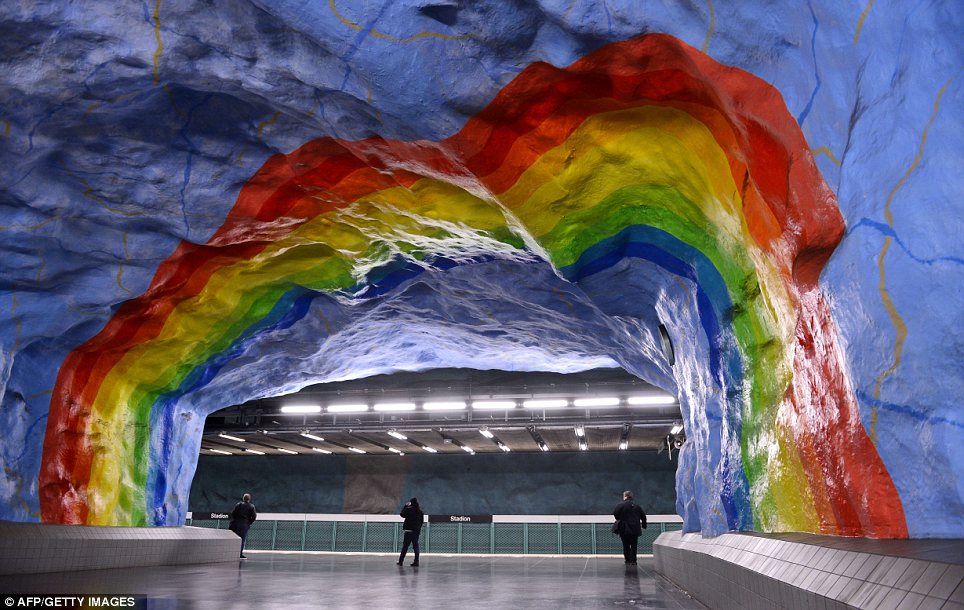-

Stockholm Metro Art
Train stations play an integral role in the community and their locations feed the city’s social and cultural hubs, providing transport to many who do not have access to a car, and act as a meeting place of sorts for many segments of the community. Many Melbournian stations fail to incorporate elements of public artwork and become spaces of anonymity, leaving commuters disengaged.

Santiago Metro, Chile
When the construction of railway infrastructure was at its height, much consideration was taken in designing train stations. These gateways to the city contained intricately ornate artwork and design which reflected the pride and prestige of the city. Melbourne’s own Flinders Street Station and New York City’s Grand Central Station are two renowned railway structures, famous for their iconic architecture.
In the recent development by Neometro, Jewell Station will receive a much-needed overhaul which includes a makeover for the busy, yet narrow, Upfield bike trail. Located 5kms from Melbourne’s CBD, the plans include creating accessible, meaningful and vibrant spaces for commuters. This is just one example how train stations are being brought to life by public art.
Community, as defined for this article, is a ‘social construct incorporating four elements: people, meanings, practice and spatial configurations’. We occupy countless private and public social arenas in our daily life: in our homes, workplaces, shopping centres and train stations. If we occupy a space that we deem to be unpleasant, our perception of that space may be filled with anxiety and apprehension. Beyond the aesthetics of public artwork, is it possible its presence has a positive influence on a person’s commuting experience?

NYC Subway Art
Public perceptions surrounding train stations have always been mixed. As part of the 2002 ‘Train Stations as Places for Community Wellbeing’ study, one commuter indicated that ‘[she] probably wouldn’t come here at night alone. It’s pretty far from the street so if anything happened and no one was in the station, no one could see’. This sentiment is despite the growing presence of CCTV and Public Safety Officers (PSOs) at train stations. Some people believe that this presence only legitimises public perceptions of fear and the view that stations are places of danger and uncertainty.
This is where public art plays a crucial role in effective place-making. Train stations and rail corridors that lack care and upkeep are prone to acts of vandalism and are riddled with street graffiti encouraging an unsavoury perception whereas places with commissioned mosaics, murals and other forms of art enhance civic engagements and feelings of community and inclusion.

Stockholm Metro Art
‘Community arts should be used for entertainment and diversion,’ says Carlie from North Fitzroy, who believes train stations should feature sanctioned graffiti, sculptures, creations from young, local and aspiring artists, encouraging a warmer perception of social inclusion and safety.
ock

Stockholm Metro Art
RMIT University have partnered with key transport stakeholders and are aware of the urban and social qualities of public artwork at train stations. They commissioned the Changing Face artwork for the Footscray line – specifically Footscray, West Footscray, Tottenham and Sunshine stations. ‘Each of the works have settled into their surrounds and become an important part of the station’s sense of place and identity’, says Clare McCrakken, Art in Public Space researcher.
The link between public artwork and positive wellbeing extends beyond Melbourne’s train network. London and Stockholm both promote rail corridor artwork to improve commuter’s wellbeing. Art Underground in London maintains London’s identity by commissioning anything from large-scale projects at Gloucester Road station, to pocket Tube map cover commissions. In Stockholm’s train network, the world’s longest art exhibition exists; a retelling of the Swedish capital’s story from political upheaval to the post-modern movement, through a series of paintings, sculptures and mosaics.

Stockholm Metro Subway Art
Birgitta Muhr – a famous Swedish sculptor whose work can be viewed at Högdalen station – explains the benefits of public art and train networks. Citing residential expansion, ‘a subway system needed to be created to connect the city, and they wanted art to come to every man and woman’.
When reflecting on her design, Muhr says that ‘they really encapsulated the feeling of being home and being safe. And so I began with these bright patterns’. She included tulips in bronze in hopes that it ‘would plant a little smile in the minds of the people waiting alongside them, even if just for a fleeting moment’.

Train stations can be brought to life through art and go beyond providing an aesthetic; they enable people to create positive place-making experiences and facilitate feelings of social inclusion. Bringing it back to Melbourne, more can be done to invigorate the corridors of the city’s public transport network. Making use of our rich history and retelling local’s stories through public spaces will deepen the commuters’ connection to the place they occupy. Sourcing local talent – of which we have no shortage – to produce uniquely expressive pieces of public art will put an end to creepy corridors and instead an iconic Melbourne creative space will take its place.
Words: Ross Battaglia